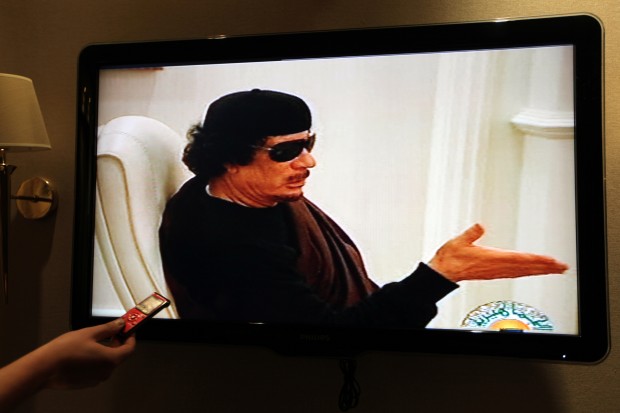
A picture taken in Gaza city on May 11, 2011, shows Libyan state TV showing footage of strongman Muammar Gaddafi in a meeting. (Mahmud Turkia/AFP/Getty)
The men who gathered around the television screen had been talking and joking without pause for several hours straight, but when Mohammed pressed the ‘play’ button they all fell silent and watched. This was the place they came to every afternoon: a cinderblock shack draped with the new Libyan flag, which had been the headquarters of their rebel brigade during the revolution. The man on the screen was familiar, too, but they had never seen him quite like this before.
It was Colonel Muammar Gaddafi, the man who had dominated their country for forty-two years and whom they had all played their part in toppling. But this wasn’t Gaddafi the statesman. It was Gaddafi the family man: relaxing on a sun lounger, playing with his children, joking with his staff in the desert. More than two years after his death, he still had the power to pull an audience.
The footage belonged to Mohammed, the man who had pressed the play button. From 1985 to 1991 he was Gaddafi’s personal photographer and filmmaker, given access through his camera lens to every part of the dictator’s life. It was not a job he’d asked for, much less one that he wanted. He was studying in the UK when he received a phone call, telling him that Gaddafi had seen some footage he had shot on Libyan state television, and that the leader wanted him to work for him full time. Refusal was not an option. Mohammed packed his belongings and returned to Libya.
[inset_right]The footage belonged to Mohammed, the man who had pressed the play button. From 1985 to 1991 he was Gaddafi’s personal photographer and filmmaker.[/inset_right]
As the footage played he told anecdotes that painted a picture of a grandiose, paranoid and increasingly sadistic dictator. Some drew peals of delighted laughter. “Once Gaddafi went hunting,” he said. “He tried to shoot a duck, but he missed and it flew off. His security guard was so terrified of him that he told him he’d shot it so hard that the force had made it shoot off like that!”
Others stories demonstrated that Gaddafi could, on occasion, be generous. Mohammed said that every time he produced something that his boss was especially happy with, he gave him a new car. “I had three new Land Rovers in six years!” Mohammed told us.
At other times that generosity backfired for Mohammed. When the President of Chad came on an official state visit to Libya, he expressed his envy at Gaddafi having his own filmmaker. Gaddafi, clearly in a giving mood, said that he could have Mohammed. “I had to go straight to Chad for three months,” he said.
But there were the darker moments alongside the quirky unpredictability. Gaddafi often asked Mohammed to film the women’s celebrations at the weddings of his staff members. Later he would watch the films, pick out the girls he wanted, and have them brought to him.
Another film showed members of the Libyan security forces kicking and beating a member of the dictator’s inner circle who had been accused of betraying Gaddafi. It was the ultimate act of sycophancy, all of them trying to kick the hardest to prove that they loved the dictator the most. “He thought his people loved him, but he never trusted the people who were closest to him,” said Mohammed. “The only people who ever knew where he was going to travel before he went anywhere were his driver and his cook.”
In the end, Mohammed hatched a plan to get out of the job he’d never wanted. He noticed that the daughter of one of Gaddafi’s security team was taking an interest in photography, so he trained her to use the camera and appointed her as his successor. His days with Gaddafi were over. He was never allowed to keep the footage he had shot of official state occasions, but the films he showed to that captive audience are his mementos of the most extraordinary time in his life: six years documenting Libya’s dictator.
